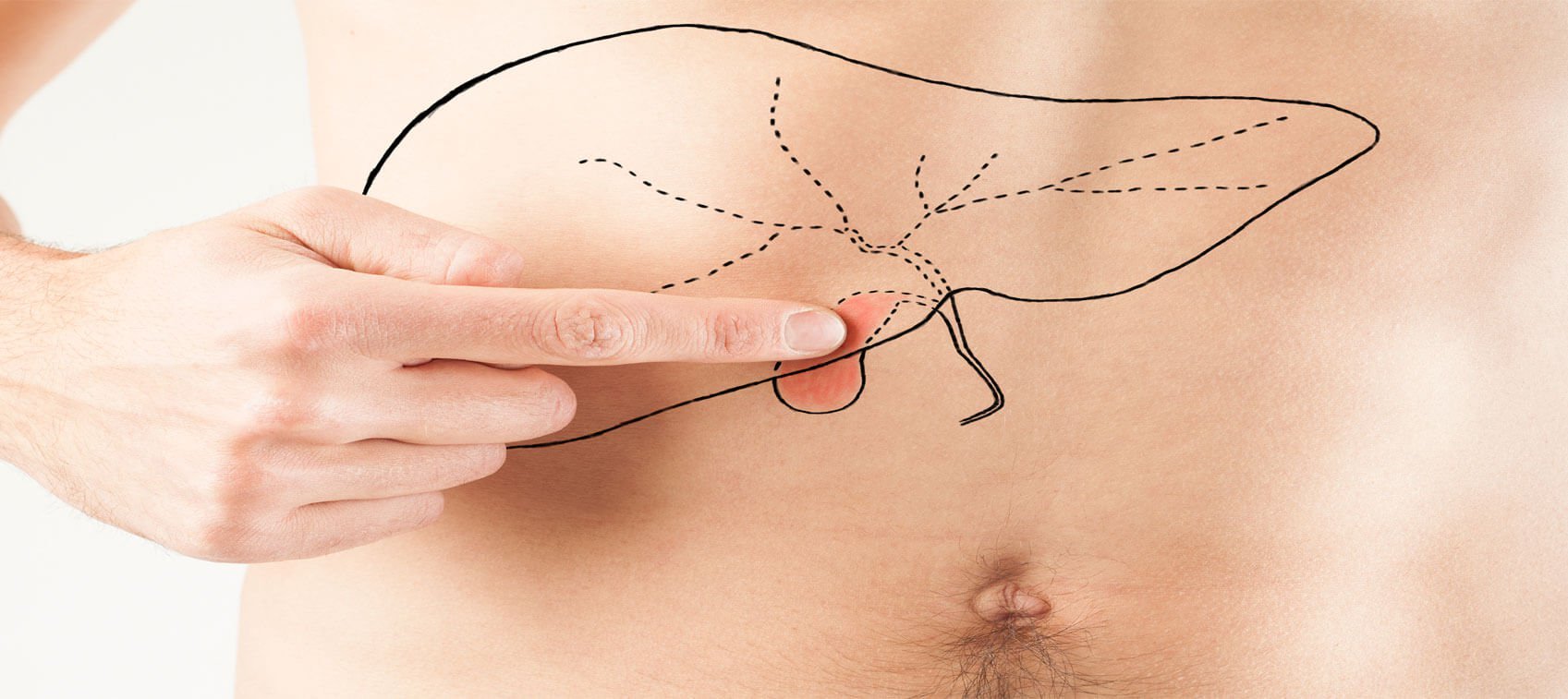
Your gallbladder is a small sack that stores and regulates bile—a fluid made in the liver that is essential to the digestion of fat.
However, if the liver is overloaded with too many toxins due to constipation; persistent drug, alcohol, or hormone use; or contaminated or highly processed foods, the bile it releases to the gallbladder can become extremely concentrated. The gallbladder can then become clogged with the thickened bile or the gallstones that can form due to the extra thick bile.
Once clogged, the gallbladder will likely begin to malfunction. Improper gallbladder function makes it difficult to digest any fats in the diet, resulting in uncomfortable symptoms such as:
- A lingering bitter taste in the mouth regardless of what you may have eaten
- A constantly runny nose
- Brilliant, blinding flashes of light that cross your visual fields
- Intestinal gas, bloating, or nausea that develops 15 to 30 minutes after eating, especially after a meal high in fat
- Chronic, recurring pain in the right shoulder or the back near the right shoulder blade or down the right side of the neck
- Painful feet
- A sore tongue
- Rectal itching
- Peeling and/or blistering of the skin on the fingers and palms of hands
Gallbladder Surgery Is Not the Best Option
Most conventional doctors feel that people can easily live without a gallbladder. So when patients go to them seeking treatment for a bad gallbladder, all too often the recommendation is surgical removal. As a result, over half a million people in the US alone lose their gallbladder to surgery each year—and they are most often told there will be few, if any, long-term negative consequences.
In my opinion, this is a crime.
Bile acids are produced from cholesterol in your liver and then flow into your gallbladder where they are stored and concentrated as much as fivefold. As your body senses the movement of fat into the small intestine, the gallbladder releases the bile to emulsify the fat—making it easier to absorb. As the bile continues through the digestive tract, 90 to 95 percent of it is reabsorbed from the large intestine and returned to the liver, where it is reused as many as 20 times.
With a healthy gallbladder, proper amounts of bile are released into the digestive tract as needed. But once the gallbladder has been removed, there is a continuous trickle of bile into your system regardless of the presence or absence of fat. The failure to match bile output to fat presence jeopardizes one’s ability to properly digest fat and, eventually, leads to deficiencies in fat–soluble vitamins and essential fatty acids, poor cholesterol metabolism, and the absorption of improperly digested fat globules. As a result, you may experience a wide variety of symptoms and problems such as:
- Skin disorders
- Vision and eye problems (cataracts)
- Fatty tumors
- Bruising
- Strokes
- Atherosclerosis
To avoid these health concerns after the removal of your gallbladder, there is one step every patient should take: Use bile salt supplements regularly, with every meal. Fortunately, these are readily available online and at health food stores.
And if you have gallstones and your doctor is recommending surgery, try high-energy shock wave treatment first. Doctors first established the technique of using a machine known as a lithotripter that uses high-energy shock waves to disintegrate kidney stones. The method was such a success that the same technique is now being used for gallstones. Not only does this procedure leave your gallbladder intact, it is much more cost effective than surgery and hospitalization.
Natural Treatments for a Bad Gallbladder
If you still have your gallbladder and wish to boost its function, there are a few natural treatments you can try that are safe, effective, and can save you from having surgery.
Flush the Gallbladder Out
To ensure a free flow of bile, both into and out of the gallbladder, you should clean this organ out with a gallbladder flush. It's simple to perform, but if you have a history of gallstones or other gallbladder issues, I suggest you check with your doctor first to rule out the possibility that you have any large calcified gallstones that might not be able to pass through the bile duct during the flush.
The gallbladder flush requires one week, beginning on a Monday and ending on a Sunday. Before you begin, you'll need to purchase:
- Plenty of apple juice or cider (not concentrate, but the real thing, without added sugars)
- Standard Process Disodium Phosphate Capsules (You can purchase these online.)
- Citrus fruits for fresh-squeezed juice (you can substitute canned or bottled citrus fruit if you prefer) and to eat whole
- Unrefined olive oil
- Lemon juice
Starting on Monday morning, follow these instructions:
- Monday morning through noon on Saturday, drink as much apple juice or apple cider as your appetite will permit, in addition to your regular meals.
- At noon on Saturday, eat a normal lunch.
- Three hours later (at 3 pm), take 1 serving (3 capsules) of disodium phosphate with 8 ounces of water.
- Two hours later (at 5 pm), repeat step 3.
- Limit your evening meal to grapefruit or grapefruit juice, or other citrus fruits or juices.
- At bedtime, take either ½ cup of unrefined olive oil followed by a small glass of grapefruit juice, or ½ cup of warm, unrefined olive oil blended with ½ cup of lemon juice.
- Go immediately to bed. For the first 30 minutes, lie on your right side with your right knee pulled up close to your chest.
- The next morning, one hour before breakfast, take 1 serving (3 capsules) of disodium phosphate with 8 ounces of water.
Continue with your normal diet and activities.
Some people feel slightly nauseated while they're drinking the olive oil and citrus juice mixture. If you do, don't fret. The feeling will disappear soon enough.
You may also feel some discomfort in the area of your gallbladder—what's known as the upper right quadrant, on the right side of your abdomen just below the rib cage. This is actually a good sign because it indicates your gallbladder is being stimulated. This feeling will also pass with time.
On Sunday, you'll likely feel the urge to defecate and may notice a change in the nature of your bowel movement. This is natural and is a result of the increased amount of bile released after the gallbladder flush.
Some people report the presence of what look like dark green peas or even marbles in their stool. This is softened material from the gallbladder that has not yet become calcified. Again, it's no cause for alarm, and indicates that the gallbladder cleansing has been effective.
Eat Food that Promote Bile Flow
There are a number of foods and supplements that can stimulate the production and flow of bile, whether you have a bad gallbladder or even after the removal of your gallbladder. Try:
- Red beets and beet top extracts. Beets are rich in betaine, which stimulates liver cell function and provides a protective effect for the liver and bile ducts. Combining beet extracts with bile salts improves the overall effectiveness. You can find these extracts at many health food stores.
- Artichokes. Leaves from the artichoke plant contain caffeoylquinic acids, which promote bile flow. The simplest and least expensive way to benefit from these compounds is to eat the artichoke leaves. They're easy to both prepare and eat. Place two artichokes in a shallow, glass baking dish with about ½- to1-inch of water in the bottom. Cover with plastic wrap and cook in a microwave on high for four to five minutes. To eat, simply break off each leaf and scrape the flesh from the leaf between your teeth and throw the pithy part of the leaf away.
- Sauerkraut and sauerkraut juice. When used regularly, sauerkraut and its juice will promote bile output. A cup of the juice by itself taken once or twice a week before breakfast can work wonders.
Manipulation to Promote Bile Flow
Stimulating certain reflex points can also help normalize the flow of bile, whether you have a bad gallbladder or even after the removal of your gallbladder. The following technique is adapted from the brilliant work of Dr. Bertrand de Jarnette. It involves the use of a combination of acupuncture meridian points, as well as foot and neurolymphatic reflexes. Two or three sessions over the first week followed by a weekly session can make a dramatic difference in the way you feel. All you need is an able and willing assistant.
The four points you need to know are:
- Acupuncture point large intestine-4 or LI-4, located in the web of skin between the thumb and index finger on the right hand.
- The reflex point for the small intestine on the bottom of the right foot.
- The edge of the rib cage overlying the gallbladder, which also happens to be the acupuncture alarm point for the gallbladder or GB-24.
- The area where the gallbladder bile duct and the pancreatic bile duct meet before dumping into the small intestine (also called the Ampulla of Vater) is located 1½ inches to the right of the bellybutton and then 3 inches below that.
There are five steps to the procedure:
- Grasp the LI-4 point on the patient's right hand between your thumb and index finger and apply a squeezing pressure with a circular-type motion until the pain in the area decreases.
- Using your thumb, rub the bottom of the right foot in a circular motion until the pain begins to subside.
- Cup your right hand so that the ends of your fingers are even and gently contact the bottom edge of the right rib cage. Hold just a slight pressure there for a minute or so to help relax the gallbladder. You may feel a gurgling or emptying of the gallbladder. Once you've performed the above three steps, then proceed with the next two.
- With your left thumb and index finger, again grasp the LI-4 point on the right hand. Place your other index finger over the Ampulla of Vater. Apply about 2 lbs. of pressure to each site and hold it for three or four minutes.
- Next, apply direct, steady pressure of about 4 lbs. to the reflex point on the bottom of the right foot while at the same time applying 2 lbs. of pressure with your opposite hand to the Ampulla of Vater.


